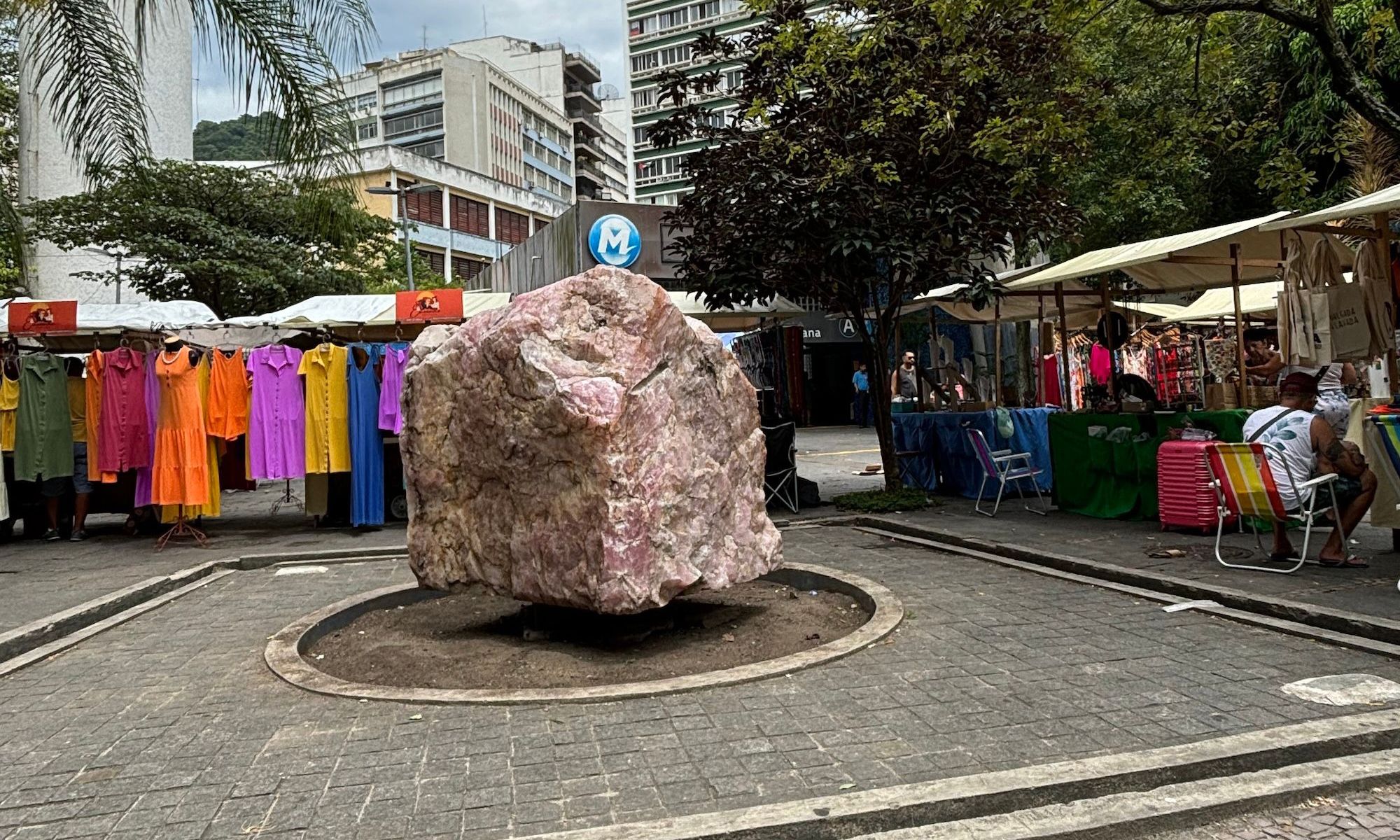Amelia Toledo’s Palácio de Cristal (1998) as it stands today Photo: Courtesy Galeria Nara Roesler
A monumental public work made by the late Brazilian artist Amelia Toledo (1926-2017) in Rio de Janeiro will be restored as part of an initiative between Galeria Nara Roesler, which represents the artist’s estate, and the Secretary of Environment and Climate of the City of Rio de Janeiro, in partnership with the Brazilian Institute of Architects in Rio de Janeiro (IAB-RJ).
The 1.4m-tall rose-quartz sculpture Palácio de Cristal (Crystal Palace) was installed in 1998 in Copacabana’s Praça Cardeal Arcoverde to inaugurate the adjoining Cardeal Arcoverde metro station. The work initially featured a fountain and was surrounded by a containment wall and a reflecting pool, which was later drained to prevent the public from using it as a washbasin after it became clogged with sand from the nearby beach.
“A series of political decisions made by the city changed the original work over time,” Daniel Roesler, director of Galeria Nara Roesler, tells The Art Newspaper. “When the water was turned off, the containment wall was also taken down. The work gradually became disfigured.”
The restoration, its first since the work was unveiled, involves refilling the reflecting pool and restarting the fountains, restoring the containment wall and cleaning the rose quartz to recover the light and colour of the crystal. The asymmetrical block with striking pink and white veins was quarried in the northeastern Brazilian state of Rio Grande do Norte.
Palácio de Cristal is one of several Toledo works commissioned by the Rio de Janeiro metro as part of the architect João Batista Martinez Corrêa’s plan for the station, a cavernous space with stone walls that is itself “like a rock museum”, Roesler says. The project resonated with Toledo, who started producing work using raw extractive materials in the mid-1980s.
“It was very much in line with what Amelia was developing at the time—this idea of sourcing materials hidden from light that were buried beneath the earth, and showing them as works of art,” Roesler says. “She wanted to use this powerful rose quartz to energise people coming in and out of the station.”
Amelia Toledo’s Palácio de Cristal (1998) when it was first installed as a fountain sculpture Photo: Fernando Chaves
Inside the Cardeal Arcoverde station, Toledo also created Projeto Cromático (Chromatic Project), a series of 68 coloured panels that line the walls of a passageway; a floor panel titled Embarque na Estação Terra (Boarding on Station Earth); and the stainless-steel panel Por dentro da Terra (Inside the Earth).
The works inside the station are not part of the current restoration project but have been similarly neglected over the years—and at times covered with advertisements. Roesler hopes that the initiative to restore Palácio de Cristal prompts other art-conservation projects around Rio de Janeiro, including the preservation of Toledo’s other pieces at the station.
“These works are part of the history of Rio, and it’s a shame there were no efforts to take care of them until now,” Roesler says. “We’ve received amazing support from the city for this project. The idea of having Palácio de Cristal restored was well-received from the start.”
Galeria Nara Roesler launched the project to commemorate its tenth anniversary in Rio de Janeiro this year, funding it in its entirety with consultancy from the city and the IAB-RJ, which was involved in the original commission. Restoration began last year and is scheduled for completion in late September, costing between $10,000 and $20,000. “The overall cost is still unclear, but it’s a commitment that we’ve made, and we’re going to get it done,” Roesler says.
Toledo was on Galeria Nara Roesler’s original artist roster when it first opened in São Paulo in 1989. Her work will be featured at the gallery’s stand at ArtRio in September, where there are plans to celebrate the restored Palácio de Cristal and its significance to Brazilian heritage.
Over the summer, the Brazilian Museum of Sculpture and Ecology (Mube) in São Paulo hosted a survey of Toledo’s work, Paisagem Cromática, which broke visitor-attendance records for the museum and included the artist’s original sketches for Palácio de Cristal.
In an interview in 1999, Toledo said that the sculpture had been inspired by the critic Casimiro Xavier de Mendonça, who on his deathbed asked her to build him a “crystal palace”. She found the rose-quartz quarry some years later, honouring Mendonça with the work. “It is on the water mirror of the fountain of the square,” she said, “bathed by a constant flow of tears.”

